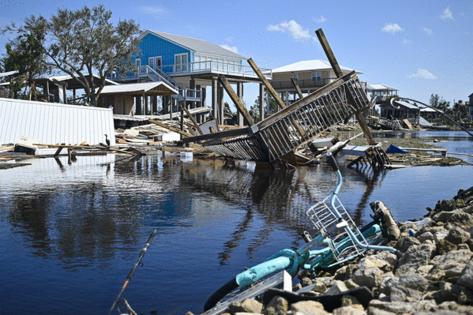By the numbers: How 2024's 'extremely active' hurricane season brought storm after storm
Published in Science & Technology News
FORT LAUDERDALE, Fla. — The 2024 hurricane season has hurled one storm after another, with some of those storms turning deadly.
And the season, which ends Nov. 30, didn’t let up in recent days, with Tropical Storm Sara forming in the western Caribbean Sea.
Here’s a look at what the season — which forecasters earlier this year said would be “extremely active”— has brought this year, by the numbers.
—18 named storms
There have been that many named storms as of Nov. 15. That’s nearly five more storms than the Nov. 10 average of 13.8, from 1991 to 2020.
—11 hurricanes
There were that many hurricanes this year in the Atlantic Basin, exceeding the 30-year average from 1991 to 2020 of 6.9. This year’s 11 hurricanes and counting even topped 2023.
Last year had the fourth most named storms in recorded history, with 20, but only seven powered up to become hurricanes.
Five made landfall in the U.S.
The first was Hurricane Beryl, a rare June major hurricane and the earliest Category 5 Atlantic hurricane on record.
Beryl hit the island of Carriacou in Grenada as a high-end Category 4 on July 1, then made its way to the Yucatán Peninsula as a high-end Category 2 hurricane early on July 5. It then headed to Matagorda, Texas, where it made landfall as a Category 1 storm with maximum sustained winds of 80 mph.
According to NOAA, Hurricane Beryl caused approximately 20 fatalities in the Caribbean region and around 25 additional deaths in Texas, Louisiana, and even Vermont.
Hurricane Debby made landfall on Aug. 5 in Florida’s Big Bend region as a Category 1 storm with maximum sustained wind speeds of 80 mph. Debby’s torrential rainfall triggered both flash floods and river flooding across the southeastern U.S., especially from Florida to the Carolinas. Freshwater flooding persisted for several weeks in the Suwannee River basin.
Storm surge on the Gulf coast, which reached 3-5 feet in the Big Bend region, had a silver lining. It uncovered a WWII message in a bottle.
Nine people died in the Caribbean and five people died in the southeastern U.S., including a 13-year-old boy in Levy County, Florida, who was killed when a tree fell on his home.
Hurricane Francine formed off Mexico and made landfall in Louisiana on Sept. 11 with sustained winds of 100 mph.
Then came one of the most shocking storms of the year. Hurricane Helene made landfall near Perry, Florida, on Sept. 26 as a Category 4 storm with 140 mph sustained winds. The storm killed more than 230 people across six states. Fourteen of those deaths occurred in Florida.
The speed of the storm carried its forces inland. Four days of rain in mountains of southern Appalachia, with some areas receiving 30 inches, turned creeks into torrents that scrubbed entire towns from the map.
October brought Hurricane Milton, the most intense Atlantic Basin storm since 2019’s Dorian. Milton intensified explosively into a Category 5 storm in the Gulf of Mexico and went toward Siesta Key south of Tampa, where it made landfall on Oct. 9 as a Category 3 storm with 120 mph sustained winds.
There was plenty of destruction on Florida’s west coast, but here in the east coast, Milton’s track put South Florida in the most deadly quadrant of the storm.
As a result, the hurricane, which tracked about 170 miles away from Broward County, spawning at least 47 tornado reports across southern Florida, from Fort Myers to Homestead, Palm Beach County and north to Martin and St. Lucie counties. One of the tornadoes, which cut through Spanish Lakes Country Club Village, a retirement community in St. Lucie County, killed six people.
As of Nov. 14, this hurricane season has caused more than 300 fatalities and nearly $190 billion in damage.
Most of the deaths are because of Beryl, Helene, and Milton, while most of the damage is due to Helene and Milton.
—5 major hurricanes
We’ve had five major hurricanes this year.
The 30-year average was 3.1. Last year, we saw 3.
Those hurricanes were Beryl; Category 4 Kirk weakened into a post-tropical cyclone before heading to Europe; Helene; Milton and Rafael.
Rafael formed south of Cuba and cut through western Cuba as a Category 3 storm with 115 mph winds. No deaths were reported.
—74.25 storm days
There have been that many storm days this year compared to the 66.2 average. Storm days are the total amount of days in which there is an active tropical storm or hurricane.
With only a few days left in the season, 2024 won’t catch 2023, which had 100.5.
—November norms
“Usually by November we’re talking about next season already,” said meteorologist Jeremy Nelson of WJCL in Savannah, Georgia, on his Tracking the Tropics segment on X.
Tropical Storm Sara changed that. Sara was skirting the northern coast of Honduras on its way into the Yucatan Peninsula, but it was set to weaken quickly over land before traveling into the Bay of Campeche in the Gulf of Mexico. Forecasters expected it to dissipate there.
Although unusual, November hurricanes do happen.
Hurricane Nicole made landfall at Vero Beach on Nov. 10, 2022.
Hurricane Kate cut across Cuba and made U.S. landfall near Mexico Beach, Florida, on Nov. 22, 1985.
And on Nov. 3, 1935, Hurricane Yankee hit Miami.
“I think once we get this system through, we’re finally going to tap into some of these stronger cold fronts,” said Nelson. “Hopefully once that happens, maybe we see a trend where the season wraps up quickly.”
©2024 South Florida Sun Sentinel. Visit at sun-sentinel.com. Distributed by Tribune Content Agency, LLC.







Comments